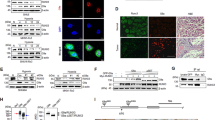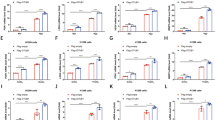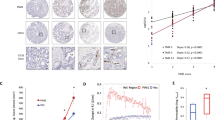Abstract
Hypoxia-inducible factor-1α (HIF-1α) is a transcription factor that has a central role in the regulation of tumour metabolism under hypoxic conditions. HIF-1α stimulates glycolytic energy production and promotes tumour growth. Sirtuins are NAD+-dependent protein deacetylases that regulate cellular metabolism in response to stress; however, their involvement in the hypoxic response remains unclear. In this study, it is shown that SIRT2-mediated deacetylation of HIF-1α regulates its stability in tumour cells. SIRT2 overexpression destabilized HIF-1α under hypoxic conditions, whereas HIF-1α protein levels were high in SIRT2-deficient cells. SIRT2 directly interacted with HIF-1α and deacetylated Lys709 of HIF-1α. Deacetylation of HIF-1α by SIRT2 resulted in increased binding affinity for prolyl hydroxylase 2, a key regulator of HIF-1α stability, and increased HIF-1α hydroxylation and ubiquitination. Moreover, a pharmacological agent that increased the intracellular NAD+/NADH ratio led to the degradation of HIF-1α by increasing SIRT2-mediated deacetylation and subsequent hydroxylation. These findings suggest that SIRT2-mediated HIF-1α deacetylation is critical for the destablization of HIF-1α and the hypoxic response of tumour cells.
This is a preview of subscription content, access via your institution
Access options
Subscribe to this journal
Receive 50 print issues and online access
$259.00 per year
only $5.18 per issue
Buy this article
- Purchase on Springer Link
- Instant access to full article PDF
Prices may be subject to local taxes which are calculated during checkout







Similar content being viewed by others

References
Weidemann A, Johnson RS . Biology of HIF-1alpha. Cell Death Differ 2008; 15: 621–627.
Melillo G . Inhibiting hypoxia-inducible factor 1 for cancer therapy. Mol Cancer Res 2006; 4: 601–605.
Zhang D, Li J, Costa M, Gao J, Huang C . JNK1 mediates degradation HIF-1alpha by a VHL-independent mechanism that involves the chaperones Hsp90/Hsp70. Cancer Res 2010; 70: 813–823.
Papadakis AI, Paraskeva E, Peidis P, Muaddi H, Li S, Raptis L et al. eIF2{alpha} Kinase PKR modulates the hypoxic response by Stat3-dependent transcriptional suppression of HIF-1{alpha}. Cancer Res 2010; 70: 7820–7829.
Semenza GL . HIF-1: upstream and downstream of cancer metabolism. Curr Opin Genet Dev 2009; 20: 51–56.
Denko NC . Hypoxia, HIF1 and glucose metabolism in the solid tumour. Nat Rev Cancer 2008; 8: 705–713.
Berra E, Ginouves A, Pouyssegur J . The hypoxia-inducible-factor hydroxylases bring fresh air into hypoxia signalling. EMBO Rep 2006; 7: 41–45.
Majmundar AJ, Wong WJ, Simon MC . Hypoxia-inducible factors and the response to hypoxic stress. Mol Cell 2010; 40: 294–309.
Kwon SJ, Song JJ, Lee YJ . Signal pathway of hypoxia-inducible factor-1alpha phosphorylation and its interaction with von Hippel-Lindau tumor suppressor protein during ischemia in MiaPaCa-2 pancreatic cancer cells. Clin Cancer Res 2005; 11: 7607–7613.
Cheng J, Kang X, Zhang S, Yeh ET . SUMO-specific protease 1 is essential for stabilization of HIF1alpha during hypoxia. Cell 2007; 131: 584–595.
Jeong JW, Bae MK, Ahn MY, Kim SH, Sohn TK, Bae MH et al. Regulation and destabilization of HIF-1alpha by ARD1-mediated acetylation. Cell 2002; 111: 709–720.
Houtkooper RH, Pirinen E, Auwerx J . Sirtuins as regulators of metabolism and healthspan. Nat Rev Mol Cell Biol 2012; 13: 225–238.
Finley LW, Carracedo A, Lee J, Souza A, Egia A, Zhang J et al. SIRT3 opposes reprogramming of cancer cell metabolism through HIF1alpha destabilization. Cancer Cell 2011; 19: 416–428.
Lim JH, Lee YM, Chun YS, Chen J, Kim JE, Park JW . Sirtuin 1 modulates cellular responses to hypoxia by deacetylating hypoxia-inducible factor 1alpha. Mol Cell 2010; 38: 864–878.
Dioum EM, Chen R, Alexander MS, Zhang Q, Hogg RT, Gerard RD et al. Regulation of hypoxia-inducible factor 2alpha signaling by the stress-responsive deacetylase sirtuin 1. Science 2009; 324: 1289–1293.
Chen R, Dioum EM, Hogg RT, Gerard RD, Garcia JA . Hypoxia increases sirtuin 1 expression in a hypoxia-inducible factor-dependent manner. J Biol Chem 2011; 286: 13869–13878.
Laemmle A, Lechleiter A, Roh V, Schwarz C, Portmann S, Furer C et al. Inhibition of SIRT1 impairs the accumulation and transcriptional activity of HIF-1alpha protein under hypoxic conditions. PLoS One 2012; 7: e33433.
Krishnan J, Danzer C, Simka T, Ukropec J, Walter KM, Kumpf S et al. Dietary obesity-associated Hif1alpha activation in adipocytes restricts fatty acid oxidation and energy expenditure via suppression of the Sirt2-NAD+ system. Genes Dev 2012; 26: 259–270.
Luthi-Carter R, Taylor DM, Pallos J, Lambert E, Amore A, Parker A et al. SIRT2 inhibition achieves neuroprotection by decreasing sterol biosynthesis. Proc Natl Acad Sci USA 2010; 107: 7927–7932.
Jiang W, Wang S, Xiao M, Lin Y, Zhou L, Lei Q et al. Acetylation regulates gluconeogenesis by promoting PEPCK1 degradation via recruiting the UBR5 ubiquitin ligase. Mol Cell 2011; 43: 33–44.
North BJ, Verdin E . Mitotic regulation of SIRT2 by cyclin-dependent kinase 1-dependent phosphorylation. J Biol Chem 2007; 282: 19546–19555.
Semenza GL . Hydroxylation of HIF-1: oxygen sensing at the molecular level. Physiology (Bethesda) 2004; 19: 176–182.
Miettinen M, Lindenmayer AE, Chaubal A . Endothelial cell markers CD31, CD34, and BNH9 antibody to H- and Y-antigens—evaluation of their specificity and sensitivity in the diagnosis of vascular tumors and comparison with von Willebrand factor. Mod Pathol 1994; 7: 82–90.
Michishita E, Park JY, Burneskis JM, Barrett JC, Horikawa I . Evolutionarily conserved and nonconserved cellular localizations and functions of human SIRT proteins. Mol Biol Cell 2005; 16: 4623–4635.
Geng H, Liu Q, Xue C, David LL, Beer TM, Thomas GV et al. HIF1alpha protein stability is increased by acetylation at lysine 709. J Biol Chem 2012; 287: 35496–35505.
Wang F, Chan CH, Chen K, Guan X, Lin HK, Tong Q . Deacetylation of FOXO3 by SIRT1 or SIRT2 leads to Skp2-mediated FOXO3 ubiquitination and degradation. Oncogene 2012; 31: 1546–1557.
Berra E, Benizri E, Ginouves A, Volmat V, Roux D, Pouyssegur J . HIF prolyl-hydroxylase 2 is the key oxygen sensor setting low steady-state levels of HIF-1alpha in normoxia. EMBO J 2003; 22: 4082–4090.
Outeiro TF, Kontopoulos E, Altmann SM, Kufareva I, Strathearn KE, Amore AM et al. Sirtuin 2 inhibitors rescue alpha-synuclein-mediated toxicity in models of Parkinson's disease. Science 2007; 317: 516–519.
Kim HS, Vassilopoulos A, Wang RH, Lahusen T, Xiao Z, Xu X et al. SIRT2 maintains genome integrity and suppresses tumorigenesis through regulating APC/C activity. Cancer Cell 2011; 20: 487–499.
Hwang JH, Kim DW, Jo EJ, Kim YK, Jo YS, Park JH et al. Pharmacological stimulation of NADH oxidation ameliorates obesity and related phenotypes in mice. Diabetes 2009; 58: 965–974.
North BJ, Marshall BL, Borra MT, Denu JM, Verdin E . The human Sir2 ortholog, SIRT2, is an NAD+-dependent tubulin deacetylase. Mol Cell 2003; 11: 437–444.
Terzuoli E, Puppo M, Rapisarda A, Uranchimeg B, Cao L, Burger AM et al. Aminoflavone, a ligand of the aryl hydrocarbon receptor, inhibits HIF-1alpha expression in an AhR-independent fashion. Cancer Res 2010; 70: 6837–6848.
Hiratsuka M, Inoue T, Toda T, Kimura N, Shirayoshi Y, Kamitani H et al. Proteomics-based identification of differentially expressed genes in human gliomas: down-regulation of SIRT2 gene. Biochem Biophys Res Commun 2003; 309: 558–566.
Page EL, Robitaille GA, Pouyssegur J, Richard DE . Induction of hypoxia-inducible factor-1alpha by transcriptional and translational mechanisms. J Biol Chem 2002; 277: 48403–48409.
Jin Y, Wu J, Song X, Song Q, Cully BL, Messmer-Blust A et al. RTEF-1, an upstream gene of hypoxia-inducible factor-1alpha, accelerates recovery from ischemia. J Biol Chem 2011; 286: 22699–22705.
van Uden P, Kenneth NS, Rocha S . Regulation of hypoxia-inducible factor-1alpha by NF-kappaB. Biochem J 2008; 412: 477–484.
Kaelin Jr. WG, Ratcliffe PJ . Oxygen sensing by metazoans: the central role of the HIF hydroxylase pathway. Mol Cell 2008; 30: 393–402.
Tanaka H, Li Z, Ikuta K, Addo L, Akutsu H, Nakamura M et al. Iron facilitator LS081 reduces hypoxia-inducible factor-1alpha protein and functions as anticancer agent in hepatocellular carcinoma. Cancer Sci 2012; 103: 767–774.
Choi HJ, Song BJ, Gong YD, Gwak WJ, Soh Y . Rapid degradation of hypoxia-inducible factor-1alpha by KRH102053, a new activator of prolyl hydroxylase 2. Br J Pharmacol 2008; 154: 114–125.
Schwer B, Schumacher B, Lombard DB, Xiao C, Kurtev MV, Gao J et al. Neural sirtuin 6 (Sirt6) ablation attenuates somatic growth and causes obesity. Proc Natl Acad Sci USA 2010; 107: 21790–21794.
Kim HS, Patel K, Muldoon-Jacobs K, Bisht KS, Aykin-Burns N, Pennington JD et al. SIRT3 is a mitochondria-localized tumor suppressor required for maintenance of mitochondrial integrity and metabolism during stress. Cancer Cell 2010; 17: 41–52.
Massudi H, Grant R, Braidy N, Guest J, Farnsworth B, Guillemin GJ . Age-associated changes in oxidative stress and NAD+ metabolism in human tissue. PLoS One 2012; 7: e42357.
Kim SY, Jeoung NH, Oh CJ, Choi YK, Lee HJ, Kim HJ et al. Activation of NAD(P)H:quinone oxidoreductase 1 prevents arterial restenosis by suppressing vascular smooth muscle cell proliferation. Circ Res 2009; 104: 842–850.
Kim YH, Hwang JH, Noh JR, Gang GT, Tadi S, Yim YH et al. Prevention of salt-induced renal injury by activation of NAD(P)H:quinone oxidoreductase 1, associated with NADPH oxidase. Free Radic Biol Med 2012; 52: 880–888.
Zhang Q, Wang SY, Nottke AC, Rocheleau JV, Piston DW, Goodman RH . Redox sensor CtBP mediates hypoxia-induced tumor cell migration. Proc Natl Acad Sci USA 2006; 103: 9029–9033.
Acknowledgements
We thank Dr HS Kim, Dr JH Lim and Dr JW Park for their skillful methodological assistance, Dr JJ Lee for the HRE luciferase plasmid and Dr KY Lee for the SIRT2 expression plasmids. This research was supported by Basic Science Research Program through the National Research Foundation of Korea (NRF) funded by the Ministry of Education (2009-1176023, 2011-0011365) (GRK) and the NRF funded by the Ministry of Science, ICT & Future Planning (2007-0054932).
Author information
Authors and Affiliations
Corresponding authors
Ethics declarations
Competing interests
The authors declare no conflict of interest.
Additional information
Supplementary Information accompanies this paper on the Oncogene website
Supplementary information
Rights and permissions
About this article
Cite this article
Seo, KS., Park, JH., Heo, JY. et al. SIRT2 regulates tumour hypoxia response by promoting HIF-1α hydroxylation. Oncogene 34, 1354–1362 (2015). https://doi.org/10.1038/onc.2014.76
Received:
Revised:
Accepted:
Published:
Issue Date:
DOI: https://doi.org/10.1038/onc.2014.76
This article is cited by
-
Dysregulation of histone deacetylases in ocular diseases
Archives of Pharmacal Research (2024)
-
Shedding light on structure, function and regulation of human sirtuins: a comprehensive review
3 Biotech (2023)
-
Gene regulation by histone-modifying enzymes under hypoxic conditions: a focus on histone methylation and acetylation
Experimental & Molecular Medicine (2022)
-
NAD+ metabolism, stemness, the immune response, and cancer
Signal Transduction and Targeted Therapy (2021)
-
Impact of the hypoxic phenotype on the uptake and efflux of nanoparticles by human breast cancer cells
Scientific Reports (2018)


